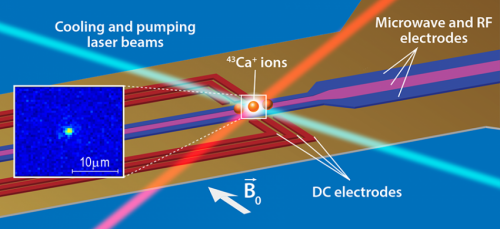November 26, 2014 report
Researchers find qubits based on trapped ions offer a promising scalable platform for quantum computing

(Phys.org) —A team of researchers working at the University of Oxford has found that quantum bits (qubits) based on trapped calcium ions can be both manipulated and fashioned to store qubits with higher fidelity than any other method seen thus far. In their paper published in Physical Review Letters, the team describes how they built a means for testing the feasibility of using Ca+ ions as the basis for quantum computing and what they found in doing so.
Scientists around the world are hard at work trying to figure out how to build a functional, useful quantum computer—while much progress has been made there are still areas that are problematic, one of which is error rate correction during the preparation, manipulation, and measurement of quantum bits inside of a quantum computer. The current belief is that error correction must be under 1 percent for any such machine to be viable—as the rate goes up, so too does the number of qubits involved in just that process, leading eventually to an untenable situation. In this new effort, the researchers looked to see if trapped Ca+ ions would lead to higher fidelities.
The researchers trapped a Ca+ ion on a sapphire substrate using an electric field—modifying the field allowed for representing "0" or "1" qubit states. In so doing, the researchers found that they could achieve a coherence time of up to 50 seconds—a record for a non-shielded atomic-ion. The researchers then used laser pumping techniques to prepare the ion's electron to a ground state, then applied optical excitation to read the qubit state. The team ran this same procedure 150,000 and reported an average error rate of just 0.07 percent—clearly much better than the 1 percent benchmark. The then applied 3.2-gigahertz microwave pulses to cause the qubits to act as logic gates—they report near perfect accuracy. They followed that up by generating a long sequence of logic gate operations which ran with an error rate of just 1×10−6—again, much better than the benchmark.
The results by the team suggest that trapped calcium ions may indeed prove to be a suitable means for representing qubits in a quantum computer, though a lot more research is yet to come—integrating all the functionalities in a single setup, for example.
More information: High-Fidelity Preparation, Gates, Memory, and Readout of a Trapped-Ion Quantum Bit, Phys. Rev. Lett. 113, 220501 – Published 24 November 2014 http://dx.doi.org/10.1103/PhysRevLett.113.220501 (Free PDF)
Abstract
We implement all single-qubit operations with fidelities significantly above the minimum threshold required for fault-tolerant quantum computing, using a trapped-ion qubit stored in hyperfine "atomic clock" states of Ca+43. We measure a combined qubit state preparation and single-shot readout fidelity of 99.93%, a memory coherence time of T∗2=50 sec, and an average single-qubit gate fidelity of 99.9999%. These results are achieved in a room-temperature microfabricated surface trap, without the use of magnetic field shielding or dynamic decoupling techniques to overcome technical noise.
Journal information: Physical Review Letters
© 2014 Phys.org




















